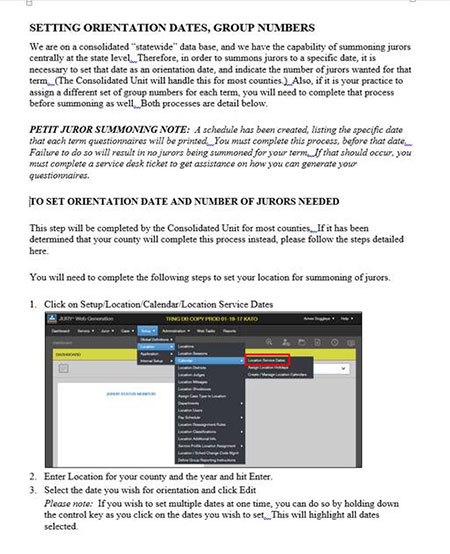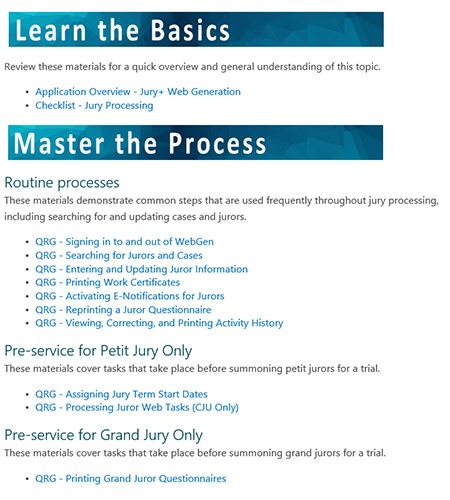By April Turitto and Kim Larson
Since the Business Education & Support Unit (BESU) was created in 2013, we’ve worked to continuously improve statewide education and training materials for Minnesota Judicial Branch employees, judicial officers, and the public. Over the last two years, the BESU took on the task of converting a decades old user manual to a more user-friendly format.
Why Change the User Manual
We chose to work on the jury user manual while analyzing training needs for the upgraded jury system. As we looked through existing training materials, we realized that all the materials were in need of updating. Instead of simply editing the existing materials with the system upgrade, we proposed a broader update to modernize all jury materials for statewide users.
The new format needed to be easy to find, use, and maintain. We decided an online format would best meet those needs, aligning our activity with Minnesota’s goal paperless courts.
The Original Manual
The existing Jury User Manual detailed all the processes users could perform in the state’s jury management system broken down by topic. The original manual was a 268-page Word document consisting of mostly paragraphs of text with several screenshots of the application. It was available on the court’s intranet site as eight chapters, a single Word document for each chapter.
Although the manual was a comprehensive collection of information, it was difficult for users to find information, especially if they weren’t familiar with jury processes. It was also a challenge for trainers working with new employees to pick out the specific items they needed during training.
Collaborating for Success
The jury manual was the main resource for jury users around the state. Converting the format after so many years would affect hundreds of people, so we had to make sure that nothing was lost. To ensure that all important information remained intact we worked closely with jury subject matter experts (SMEs), some of whom were the authors of the original manual. Initially, they were nervous about making such a large change to how we recorded jury processing information. They had spent years creating and maintaining the manual, and in turn had taken on a high level of responsibility and ownership for this information. The collaboration between training experts and jury experts made it easier to guarantee that the converted materials covered the information in such a way that was complete and accurate, yet still easy to use.
Another stakeholder group, the Jury Management Resources Team (JMRT), was also nervous about this change because of the impact it could have on their work as jury experts in their locations. They were very comfortable finding information and resources in the existing jury manual, and they were concerned that a new format would slow them down. They were also concerned that statewide users would have a hard time making the switch and would be frustrated with the change.
To help ease JMRT’s concerns, we provided regular updates and previews of the new manual well before finalizing the conversion. We gave them several opportunities to submit feedback, which made it easier for us to create a product that would best suit the end user. As we got closer to releasing the new format, having seen the progress and what the final product would look like, stakeholders were excited for the change and couldn’t wait for completion. Many members of the team agreed that the new format would make it much easier to train new employees because the layout followed the actual path of managing jurors and cases.
The Conversion Process
The actual conversion consisted of many hours combing through the manual and grouping information and processes into logical sets. We started with the main topics that pertained to the majority of jury system users, like how to summon jurors or postpone service. After picking out the larger topics we were able to look at less common practices and decide how to handle them. We eventually converted all the information into these formats:
- Quick reference guides – These outline step-by-step processes with numbered steps and screenshots.
- Application overviews – These contain screenshots of the main screens with notes on how to navigate the system.
- Handouts – These cover information that require more explanation than a quick reference guide does. They use a paragraph format with bullet points and numbering to make things easier to follow.
- Indexes – These list similar items with rows or columns that include brief descriptions. We use these to summarize things like reports, and they usually contain the report names, brief descriptions, location information, and other details.
- Frequently Asked Questions – This question and answer format works well for documenting less common practices or items that don’t fit well into broader topics.
The New Jury eGuide
The result of the conversion process is a product we call the Jury eGuide. It is a webpage that we designed to look like a table of contents, and when someone clicks on a title it opens the relevant document. For example, if someone clicks on Searching for Jurors and Cases, the quick reference guide opens with all the search-related steps. It organizes documentation based on how processes occur during the jury management life cycle, which makes it easier for trainers to use with new employees. Since each document is very specific to a certain topic or task, users no longer need to sift through paragraphs of text to find what the need. Instead, the links take them directly to a short, user-friendly resource for the specific task they are performing.
What’s next?
As we look to the future, BESU is exploring ways to get away from document-based materials altogether. Creating and maintaining webpages instead of document libraries will be more efficient and more in line with the way users process information in their daily lives.
Sample from Original Jury Manual

Screenshot of Current Jury eGuide

 Kim Larson has worked at the Minnesota Judicial Branch since 2007, and has been the manager of the Business Education and Support Unit since 2013. Prior to joining the Judicial Branch, she worked as an attorney with Mid-Minnesota Legal Assistance representing clients in family law cases, housing disputes, immigration, and civil and disability rights. Kim is a Fellow of the Institute for Court Management through the National Center for State Courts and is a graduate of Mitchell Hamline School of Law in St. Paul, MN. Kim is passionate about finding innovative and creative ways to present information to judicial officers and court staff in support of their day to day work.
Kim Larson has worked at the Minnesota Judicial Branch since 2007, and has been the manager of the Business Education and Support Unit since 2013. Prior to joining the Judicial Branch, she worked as an attorney with Mid-Minnesota Legal Assistance representing clients in family law cases, housing disputes, immigration, and civil and disability rights. Kim is a Fellow of the Institute for Court Management through the National Center for State Courts and is a graduate of Mitchell Hamline School of Law in St. Paul, MN. Kim is passionate about finding innovative and creative ways to present information to judicial officers and court staff in support of their day to day work.
 April Turitto is a first-year law student at the University of St. Thomas School of Law in Minneapolis, Minnesota. Before going to law school, she worked as a Training and Development Specialist for the Minnesota Judicial Branch where she received a 2019 Achievement Award for her work on transforming the jury program training materials. When she’s not immersed in her studies, you can find April relaxing by the lake with a puzzle book and a diet root beer.
April Turitto is a first-year law student at the University of St. Thomas School of Law in Minneapolis, Minnesota. Before going to law school, she worked as a Training and Development Specialist for the Minnesota Judicial Branch where she received a 2019 Achievement Award for her work on transforming the jury program training materials. When she’s not immersed in her studies, you can find April relaxing by the lake with a puzzle book and a diet root beer.
